
Mantidae is one of the largest families in the order of praying mantises, based on the type species Mantis religiosa; however, most genera are tropical or subtropical. Historically, this was the only family in the order, and many references still use the term "mantid" to refer to any mantis. Technically, however, "mantid" refers only to members of the family Mantidae, and not the 14 remaining families of mantises. Some of the most recent classifications have promoted a number of the mantid subfamilies to the rank of family, e.g. Iridopterygidae, Sibyllidae, Tarachodidae, Thespidae, and Toxoderidae, while other classifications have reduced the number of subfamilies without elevating to higher rank.

Mantoida is a genus of mantis in the family Mantoididae.
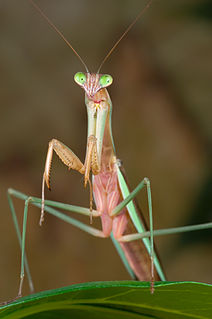
Tenodera is a genus of mantis in the subfamily Mantinae of the family Mantidae which contains several species of praying mantises. The species in this genus can be found in North America, Asia, Africa, Australia.
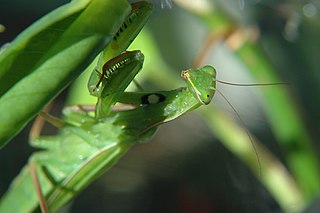
The genus Mantis is in the family Mantidae, of the mantis order Mantodea.

Choeradodis is a genus of praying mantises with common names such as shield mantis, hood mantis, and leaf mantis because of their extended, leaf-like thoraces. The distinguishing characteristic of Choreododis from which it takes its common names is a laterally expanded thorax. This adaptation for the purpose of camouflage, as well as a rounded wing case and a habit of staying relatively flattened, aid its leaf mimicry.

Dead leaf mantis is a common name given to various species of praying mantis that mimic dead leaves. It is most often used in reference to species within genus Deroplatys because of their popularity as exotic pets. Examples include D. desiccata, D. lobata, and D. philippinica. Other species to which the term may apply include Acanthops falcataria, A. falcata, and Phyllocrania paradoxa.

Brunneria is a genus of praying mantises in Family Mantidae. They are often called stick mantis for their slender shape and the species of the genus are native to the Americas.
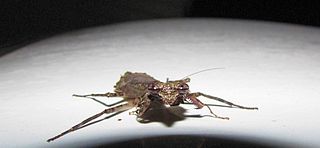
Gonatista is a genus of praying mantises in the family Epaphroditidae.

Litaneutria is a genus of ground mantises in the family Amelidae found in North America.
Pseudovates arizonae, common name Arizona unicorn mantis, is a species of praying mantis native to North America and is only found in the state of Arizona. At least three other related Pseudovates are found in Mexico, and a similar-looking species from the genus Phyllovates is found in Texas.

Iris is a genus of praying mantis found in Africa, Asia, and Southern Europe with one species, Iris oratoria, being introduced to North America in the south-western United States.

Stagmomantis limbata, common name bordered mantis, bosque mantis, Arizona mantis, or New Mexico praying mantis is a species of praying mantis native to North America, most prevalent in the Southwestern United States. This beneficial insect is green or beige in color and grows up to around 3 inches long.
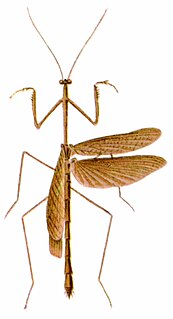
Thesprotia is a genus of mantises commonly known as grass mantis. They are native to the Americas and are represented by the following species:
Oxyothespis is a genus of praying mantis in the family Toxoderidae. Members of this genus have been called grass mantises.
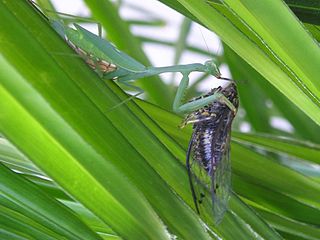
Miomantis is a genus of praying mantis in the subfamily Miomantinae.

Rivetina is a genus of praying mantises in the family Rivetinidae.

Mantises are an order (Mantodea) of insects that contains over 2,400 species in about 430 genera in 30 families. The largest family is the Mantidae ("mantids"). Mantises are distributed worldwide in temperate and tropical habitats. They have triangular heads with bulging eyes supported on flexible necks. Their elongated bodies may or may not have wings, but all Mantodea have forelegs that are greatly enlarged and adapted for catching and gripping prey; their upright posture, while remaining stationary with forearms folded, has led to the common name praying mantis.
D. intermedia may refer to:
Epsomantis is a monotypic genus of mantis in the new (2019) family Nanomantidae and contains only one species, Epsomantis tortricoides.















